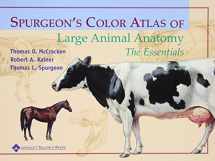
Spurgeon's Color Atlas of Large Animal Anatomy: The Essentials
ISBN-13:
9780683306736
ISBN-10:
0683306731
Edition:
1
Author:
Thomas O. McCracken, Robert A. Kainer, Thomas L. Spurgeon
Publication date:
1999
Publisher:
Wiley-Blackwell
Format:
Paperback
159 pages
Category:
Animal Husbandry
,
Agricultural Sciences
FREE US shipping
Book details
ISBN-13:
9780683306736
ISBN-10:
0683306731
Edition:
1
Author:
Thomas O. McCracken, Robert A. Kainer, Thomas L. Spurgeon
Publication date:
1999
Publisher:
Wiley-Blackwell
Format:
Paperback
159 pages
Category:
Animal Husbandry
,
Agricultural Sciences
Summary
Spurgeon's Color Atlas of Large Animal Anatomy: The Essentials (ISBN-13: 9780683306736 and ISBN-10: 0683306731), written by authors
Thomas O. McCracken, Robert A. Kainer, Thomas L. Spurgeon, was published by Wiley-Blackwell in 1999.
With an overall rating of 4.0 stars, it's a notable title among other
Animal Husbandry
(Agricultural Sciences) books. You can easily purchase or rent Spurgeon's Color Atlas of Large Animal Anatomy: The Essentials (Paperback) from BooksRun,
along with many other new and used
Animal Husbandry
books
and textbooks.
And, if you're looking to sell your copy, our current buyback offer is $0.62.
Description
Extraordinary accuracy and beautiful original artwork are just two features readers will find in this new resource, providing a basic foundation in domestic large animal anatomy. Its unique organization includes the anatomy of all organ systems in the various species, described in a consistent manner.
The book presents relevant anatomy of the following species:
- Horse (with contributors by Dr. Gayle Trotter)
- Ox (with contributions by Dr. Fran Garry)
- Sheep and goat (with contributions by Dr. Joan Bowen)
- Llama and alpaca (with contributions by Dr. LaRue Johnson)
- Swine (with contributions by Dr. LaRue Johnson)
- and chicken (with contributions by Dr. John Avens).
Features that enhance understanding:
- Carefully selected labeling helps students learn and remember structures and relationships.
- Male and female of a given species are depicted on facing pages so that topographic anatomy is easy to compare.
- Structures common to various animals are labeled several times, whereas unique structrur5es are labeled only on one or two species so students can make rapid distinctions of the structures peculiar to certain animals.
- An introduction provides readers with a background in nomenclature and anatomic orientation so they can benefit from the atlas even if they lack training in anatomy.
The Atlas depicts topographic relationships of major organs in a simple, yet technically accurate presentation that's free of extraneous detail so that those using the atlas can concentrate on the essential aspects of anatomy.


We would LOVE it if you could help us and other readers by reviewing the book
Book review

Congratulations! We have received your book review.
{user}
{createdAt}
by {truncated_author}


